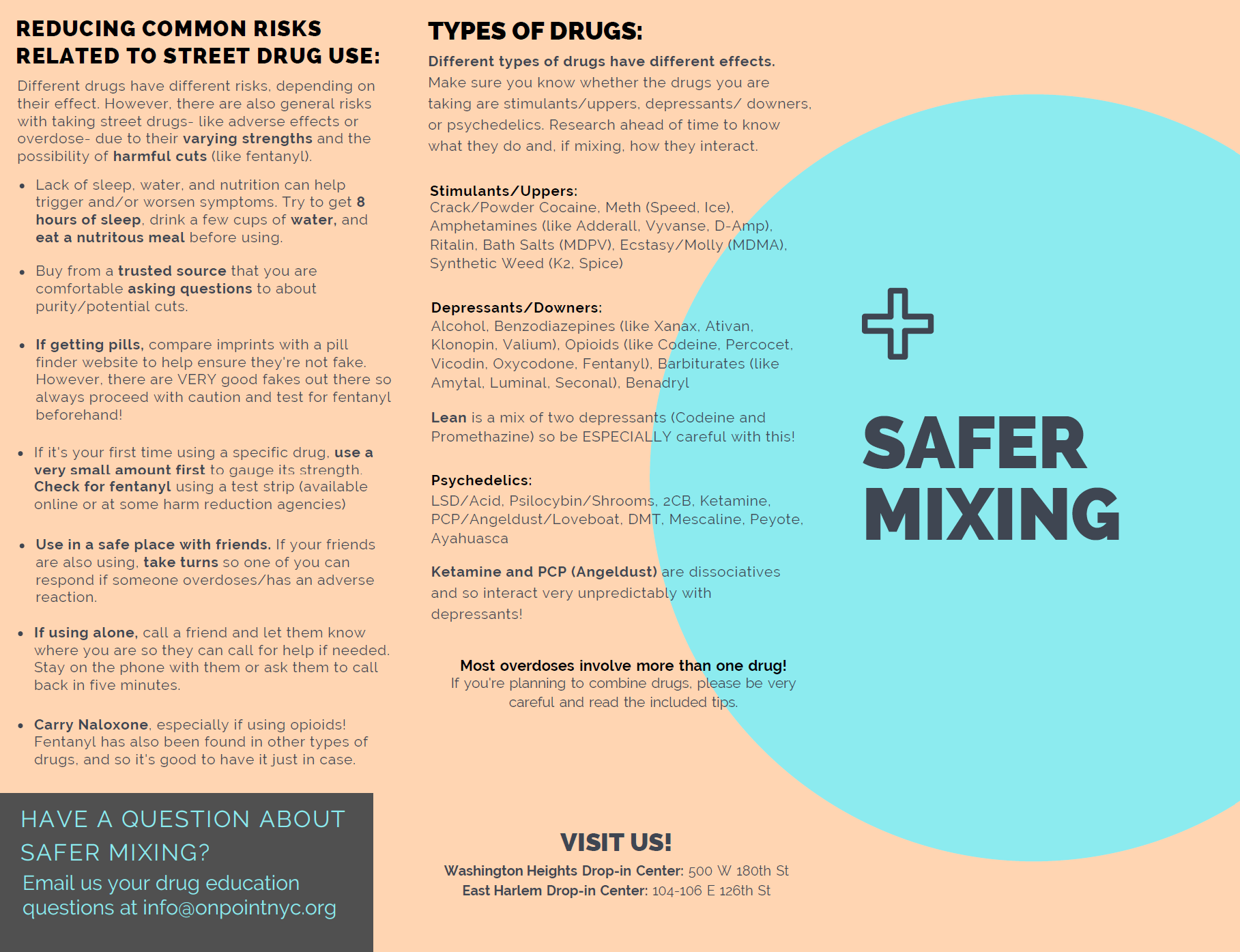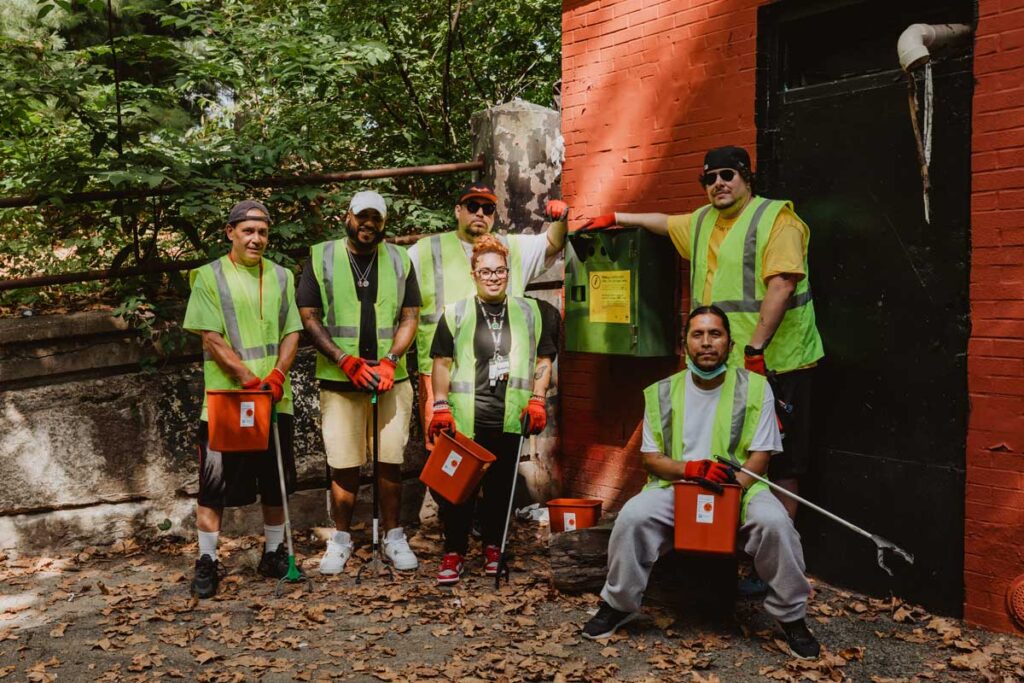
Safer Mixing Guide
REDUCING COMMON RISKS RELATED TO STREET DRUG USE:
Different drugs have different risks, depending on their effect. However, there are also general risks with taking street drugs- like adverse effects or overdose- due to their varying strengths and the possibility of harmful cuts (like fentanyl).
- Lack of sleep, water, and nutrition can help trigger and/or worsen symptoms. Try to get 8 hours of sleep, drink a few cups of water, and eat a nutritious meal before using.
- Buy from a trusted source that you are comfortable asking questions to about purity/potential cuts.
- If getting pills, compare imprints with a pill finder website to help ensure they’re not fake. However, there are VERY good fakes out there so always proceed with caution and test for fentanyl beforehand!
- If it’s your first time using a specific drug, use a very small amount first to gauge its strength.
Check for fentanyl using a test strip (available online or at some harm reduction agencies) - Use in a safe place with friends. If your friends are also using, take turns so one of you can respond if someone overdoses/has an adverse reaction.
- If using alone, call a friend and let them know where you are so they can call for help if needed. Stay on the phone with them or ask them to call back in five minutes.
- Carry Naloxone, especially if using opioids! Fentanyl has also been found in other types of drugs, and so it’s good to have it just in case.
TYPES OF DRUGS:
Different types of drugs have different effects.
Make sure you know whether the drugs you are taking are stimulants/uppers, depressants/ downers, or psychedelics. Research ahead of time to know what they do and, if mixing, how they interact.
Stimulants/Uppers:
Crack/Powder Cocaine, Meth (Speed, Ice), Amphetamines (like Adderall, Vyvanse, D-Amp), Ritalin, Bath Salts (MDPV), Ecstasy/Molly (MDMA), Synthetic Weed (K2, Spice)
Depressants/Downers: Alcohol, Benzodiazepines (like Xanax, Ativan, Klonopin, Valium), Opioids (like Codeine, Percocet, Vicodin, Oxycodone, Fentanyl), Barbiturates (like Amytal, Luminal, Seconal), Benadryl
Lean is a mix of two depressants (Codeine and Promethazine) so be ESPECIALLY careful with this!
Psychedelics:
LSD/Acid, Psilocybin/Shrooms, 2CB, Ketamine, PCP/Angeldust/Loveboat, DMT, Mescaline, Peyote, Ayahuasca
Ketamine and PCP (Angeldust) are dissociatives and so interact very unpredictably with depressants!
Most overdoses involve more than one drug!
If you’re planning to combine drugs, please be very careful and read the included tips.
STEP-BY-STEP: HOW TO MIX DRUGS MORE SAFELY
Make a plan before you use to avoid unnecessary harm and wasting money
- Decide how much you’re going to use and put aside money that you’ll need for other expenses (like food or rent).
- Buy from a source you trust and use a little bit first to test its strength. See “Reducing Common Risks Related to Street Drug Use” for more safer use advice related to purchasing street drugs.
- Plan to use in a safe place with people you trust, and make sure to eat and drink plenty of water before using anything.
- Know when the drugs will wear off so you can decide on a time to stop using, which will allow you to rest and be sober for work or other commitments.
- Are you going up or down?
Make sure you know whether the drugs you are taking are stimulants/uppers (like Adderall or cocaine) or depressants/downers (like opioids or alcohol).
Mixing drugs with similar effects can increase risk of overdose and other negative effects (like increased heart rate and/or anxiety). - Test all substances
Make sure to test all your drugs for fentanyl beforehand using test strips (available at most harm reduction agencies).
Even stimulants like cocaine, MDMA/molly, and pills have tested positive for fentanyl! - Avoid mixing depressants if possible
Depressants suppress breathing, and so mixing them carries a very high risk of overdose.
Narcan can help with opioid overdose, but it has no effect on other depressants. - Do less of each
Doing less of each drug will decrease the likelihood of an overdose or other negative effects.
You can always do more, but you can’t do less! - Take one at a time
It’s best to take the stimulant first, wait a bit, and then take the other substance.
It’s best to use stimulants and depressants separately so you can find a mix that works for you. Use LESS of the depressant than you normally would. - Keep track of how much you’re taking and when it’ll wear off
Use a pen and paper or your phone to keep track of your use. Look up when each drug wears off ahead of time to help avoid having too much in your system at once.
Stimulants normally wear off before depressants and can disguise how high you are. Avoid driving or other potentially risky activities when mixing these!
OVERDOSE RESPONSE
DON’T BE AFRAID TO CALL FOR HELP: NYS Good Samaritan Law protects you in most case if you call for emergency services for yourself or someone else who is overdosing. For more info, visit: health.ny.gov/publications/0139.pdf
PLEASE CALL FOR AN AMBULANCE IN THE EVENT OF A MEDICAL EMERGENCY!
Stimulants: Seizures, stroke, heart attack, severe overheating, psychosis
Depressants: Slow/shallow breathing or no breathing, unresponsive, bluish or grayish skin/lips/fingernails, weak or no pulse, seizures
STIMULANT OVERDOSE
Signs of Stimulant Overdose:
Fast heart rate, dizziness, irregular breathing, fever, seizures, increased body temperature/sweating, chest pain, paranoia/psychosis, erratic motion/flailing/shaking, hallucinations
SAFE SETTING: Move the person to a safe, quiet environment. Clear out the space to reduce feelings of paranoia and anxiety.
CALM THEM DOWN: Engage the person in positive conversation– tell them that they’re going to be okay. Help them walk around if they seem able to do so. Fresh air, music, low lighting, and a quiet setting can also help.
COOL THEM OFF: Use ice or cool water (cool wet cloth also works!) on wrists or forehead to cool them off. Put them next to a fan/AC if possible. If outside, try to find a shady place.
DEPRESSANT OVERDOSE
Signs of Depressant Overdose
Difficulty breathing/not breathing, unresponsive/won’t wake up, bluish or grayish skin/lips/fingernails, weak or no pulse, vomiting, seizures
ADMINISTER NALOXONE: If someone who has taken opioids/is suspected of taking opioids has signs of overdose, administer naloxone. It’s also possible to administer naloxone on yourself if you notice any of these signs. If no improvement in 4 minutes, give second dose.
GIVE RESCUE BREATHS: If the person isn’t breathing then tilt the head back, pinch the nose, and give 2 rescue breaths. Continue to give 1 breath every 5 seconds until help arrives.
LAY THEM ON THEIR SIDE: If the person is going in and out of consciousness, roll them on their side with the top arm and knee bent. This will help prevent choking on vomit, tongue, etc.
Have a Question about
Safer Mixing?
Email us your drug education questions at [email protected]
Visit Us
Locations
East Harlem
104 -106 E 126th Street
New York, NY 10035
Washington Heights
500 W 180th Street
New York, NY 10033
Email: [email protected]
Phone: (212) 828-8464
Drop-in Centers Hours
Washington Heights DIC
Monday – Friday: 7:30 AM – 11 PM
Weekends: 9 AM – 4:30 PM
East Harlem DIC
Monday – Friday: 7:30 AM – 11PM
Weekends: 10:30 AM – 6 PM
